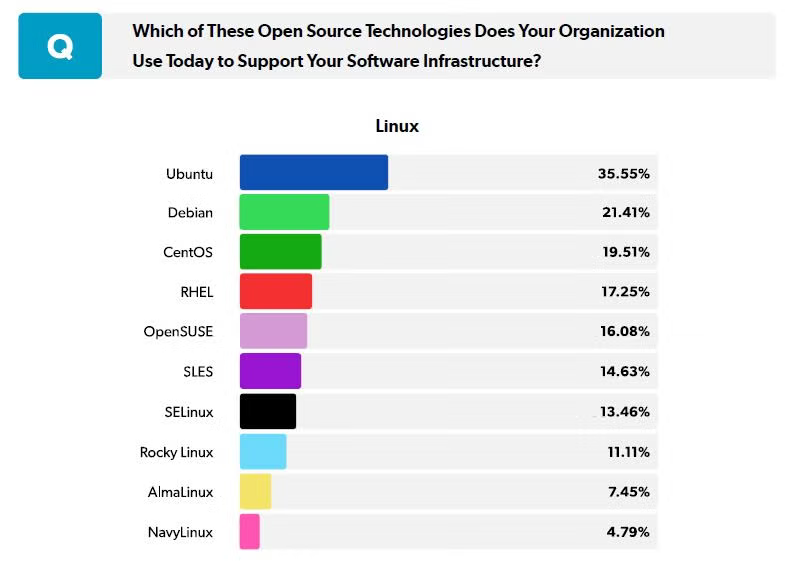Editor's Note: The new State of Open Source Report is now available, with more up-to-date information on open source operating systems.
The enterprise open source operating system landscape moves fast. And, with ongoing Enterprise Linux market shifts, determining which distributions are primed for long-term success is essential for enterprise organizations.
In this blog, we look at the top open source operating systems of 2022 and detail the community and commercial Linux distributions leading the way. We’ll also look at the new class of open source CentOS alternatives, including Rocky Linux, AlmaLinux, and NavyLinux – and discuss whether they are poised for more growth in 2022 and beyond.
The Top 5 Enterprise Linux Operating Systems of 2022
In our 2022 State of Open Source survey, we asked respondents a range of questions related to the open source technologies they use, why they use them, and the struggles they may face. Once again, one of our focus areas for the report was around open source operating systems and infrastructure technologies.
To determine the most-used open source operating systems, we created a list of the most popular Linux distribution options. There was no limit in the selection, allowing respondents to select all distributions used in their organizations.

As in previous years, Ubuntu Linux was the most popular open source operating system. In many cases, respondents selected multiple Linux distributions — indicating that respondent organizations have diverse development and production environments.
Given the recent CentOS 8 end-of-life (December 31, 2021), we saw a reduction in the use of CentOS compared to last year’s survey. That said, when combining the CentOS total with new 1:1 CentOS alternatives Rocky Linux, AlmaLinux, and NavyLinux, the combined category accounted for nearly 43% of respondents.
1. Ubuntu Linux
2022 marked another strong year for Ubuntu use, with 35.55% reporting use of Ubuntu within their organization. However, that number is significantly lower than our 2020 survey, which found 56% of respondents using Ubuntu.
2. Debian
Debian was the second most-used distribution in our survey, with 21.41% of respondents saying they used Debian within their organization. That number is slightly lower than the 22% who reported using Debian in the 2020 survey.
3. CentOS
As noted in our report, CentOS use fell sharply compared to our previous survey, with only 19.51% of respondents reporting use of CentOS distributions. Our previous survey found nearly double the percentage of respondents using using CentOS. As noted above, most of that decrease may be attributable to changes to the CentOS 8 end of life schedule, and a lack of adoption for CentOS Stream.
4. Red Hat Enterprise Linux
Red Hat Enterprise Linux (RHEL) use also decreased when compared to our previous survey, with 17.25% of respondents reporting use. Our previous survey found 25% using RHEL. This decrease, when combined with the amount of respondents using CentOS alternatives, could point to a wider flight from the RHEL ecosystem.
5. OpenSUSE
OpenSUSE came in at fifth, with 16.08% of respondents reporting use of OpenSUSE in their stacks. This number marked a sharp increase from the 2020 survey, which found only 9% of respondents using OpenSUSE.
Back to topThe Top 3 CentOS Alternatives of 2022
As noted above, new Linux distributions designed to replace CentOS, like Rocky Linux, AlmaLinux, and Navy Linux, showed significant gains — especially given the fact that they did not exist prior to 2021.

Our survey found Rocky Linux as the most-adopted distribution in this category, with 11.11% of respondents reporting use of it within their infrastructure. AlmaLinux was next at 7.45%, followed by NavyLinux at 4.79%. Combined, Rocky Linux, AlmaLinux, and Navy Linux accounted for 23.35% of respondents, eclipsing the CentOS total of 19.51%.
1. Rocky Linux
Rocky Linux has quickly picked up adoption within the Enterprise Linux landscape, with 11.11% of our respondents reporting use of Rocky Linux. Among those using CentOS alternatives, it comprised nearly half of respondents at 47.58%.
Need Technical Support for Rocky Linux? We Can Help >>
2. AlmaLinux
AlmaLinux was the second most-adopted CentOS alternative distribution in our report, with 7.45% reporting use of AlmaLinux in their organization. Among respondents using CentOS alternatives, AlmaLinux users represented 31.9%.
3. Navy Linux
Navy Linux was the third most-adopted CentOS alternative, with 4.79% of all respondents using Navy Linux within their organization. Among respondents using CentOS alternatives, it represented 20.51% of respondents.
Back to topFinal Thoughts
Our 2022 State of Open Source survey found many changes within the arena of open source operating systems. As shown above, however, the biggest changes were related to the CentOS landscape — specifically the emergence of new distributions like Rocky Linux, and the apparent flight from RHEL and CentOS Linux distributions.
Whether this data is representative of the new reality within the Enterprise Linux landscape is yet to be seen. With CentOS Stream 9 already released, and the RHEL 9 release coming soon, the speed and quality at which the respective communities can deliver Rocky Linux 9, AlmaLinux 9, and Navy Linux 9 will present a pivotal moment for these emerging CentOS alternatives.
Want More Insights? Read the Latest Report
Stay up-to-date with the trends shaping open source software by downloading a free copy of the most recent State of Open Source Report today.
Additional Resources
- Blog - Top Enterprise Linux Distributions of 2023
- Blog - Ranking the Top Open Source Data Technologies of 2022
- Blog - 2022 Open Source Report Overview: Motivations for OSS Adoption
- Blog - What to Expect in Rocky Linux 9
- On-Demand Webinar - The 2022 State of Open Source Report: Key Findings and Analysis
- Solution - AlmaLinux Support and Services
- Solution - Rocky Linux Support and Services
- Solution - CentOS Long-term Support and Services